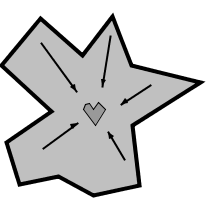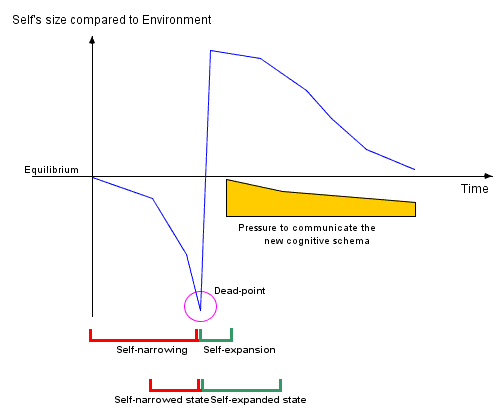- Psychology 2.0
Sex
< Aggression | List of articles related to FIPP | Artificial influences >
While playing the video press the "HQ" button (in the right bottom corner of the YouTube player) in order to improve playback quality
Fodormik's Integrated Paradigm for Psychology (FIPP)
Miklos Fodor developed a model based on three basic concepts (later highlighted in bold) that can describe human behavior in different fields of life e.g. problem solving, love, religion, sex, co-operation. The essence of the model is that it reinterprets the relationship of the Self and Environment, which to date has been considered as a static relationship. Thus, the model distinguishes
 Self-narrowing: when the Self perceives the Environment as bigger than itself e.g. in anxiety, fear, making efforts, close attention.
Self-narrowing: when the Self perceives the Environment as bigger than itself e.g. in anxiety, fear, making efforts, close attention.
 Self-expanding: when the Self expands into the Environment and perceives it as a part of itself e.g. love, happiness, aha experience, orgasm.
Self-expanding: when the Self expands into the Environment and perceives it as a part of itself e.g. love, happiness, aha experience, orgasm. The change of the two states can be described with a general pattern, in which the turning point is the emergence of new cognitive schemata, being mental constructions organized on different levels, representing the outside world e.g. concepts, theories, shapes, categories.
The emergence of a new cognitive schema results in a need to communicate, which prompts the Self to associate the new schema with others. The Self-expanding is complete only when such communication occurs.
Example: Problem solving
- Self-narrowing: as we learn more about a problem, finding a solution to it seems to be increasingly hopeless.
- Self-expanding: when the person is about to give up, a new cognitive schema establishes itself, which in turn provides a solution to the problem.
- Communicational pressure: regardless of obtaining a solution to the problem, the person does not experience complete Self-expanding until he can share it with others.
A detailed description of the model and of the basic concepts, with further examples, is provided here.
One virtue of this new model is that it integrates our knowledge of human behavior yet does not contradict psychology’s main discoveries. In addition, it harmonizes with statements of world religions and common sense.
On this page... (hide)
Sex is such a central subject of our lives and culture that it is difficult to relate anything new about it. Perhaps a new point of view can help to discover and understand previously unknown elements.
We discussed several related subjects (e.g. sleeping together, merging of body image, intimacy etc.) in previous articles, but it is worth discussing the concept of orgasm, and intercourse itself as the central topic of sex, in detail.
Note: in this topic, the word sex is used to refer to heterosexual intercourse with vaginal penetration.
1. Types of orgasm
Orgasm is more or less known to psychology, but it is also a mysterious subject. It has been known since Freud that there are two types of female orgasm, and that they differ substantially. Clitoral orgasm can be reached by stimulating the clitoris, while vaginal orgasm is a result of vaginal stimulation. (Male orgasm is said to be similar to clitoral orgasm.) Vaginal orgasm can be described (according to accounts) as a general euphoric state in which condition a longer lasting, so-called plateau phase, appears on the pleasure curve. In addition, vaginal orgasm elapses more slowly than does the male orgasm. Unlike male orgasm, it does not decrease sexual desire but increases libido. The refractory period (the “reloading” period, during which we have to rest) is much shorter as well. Compared to this, male orgasms are preceded by increasing tension; the quick dissolution of this tension is what provides men with pleasure.
Psychology talks about so many different aspects of sex that there is virtually no common denominator. However, there is. Both in the female and male Self-expansion processes occur; these last longer in one than the other. Unfortunately, nature was not evenhanded; although no one person can experience the difference, male orgasms are not only shorter, but also less intense. If we examine the curve of sexual response and the curve of Self-narrowing/expanding, the obvious similarity requires no further explanation.
What conclusions can be drawn apart from that it is the same process? It is plausible that the bigger the Self-narrowing, the bigger the Self-expansion. In other words: the more foreplay and the longer and greater the orgasm.
2. Side-effect of sex
The exaggerated emotions during and after sex (which are usually labeled as love but can be mere desire) are connected to the social demand for Self-expansion. The blurred sense of time and space, and increased tolerance of pain, all support the existence of altered states of consciousness, which occurs at the same time as the characteristics of Self-expansion are experienced.
3. Excesses and shortcomings (lacks) of the male and female bodies

The male and female body
However we look at it, we have to admit that men have some excess, and women some shortcoming, or lack, in their bodies. Something has to be done with the excess, and the lack has to be compensated for. This difference in approach determines the difference in gender behavior: men want to penetrate the Environment, to shape it, while women are the Environment itself, which needs to be penetrated. Environment can be made attractive, which attracts looks and stares, but at the same time it is not accidental that women pay more attention to their Environment in general: the interior decoration of their apartments, the garden, their own bodies (make-up, clothing &c.).
The female equivalent of male activity is that, until fairly recently, a woman could not take the initiative but could provoke a man into taking that initiative. A woman cannot penetrate another’s Environment/Self; conversely, heterosexual men have a horror of others penetrating them. Men do not penetrate an unattractive Environment with pleasure, despite its being virtually risk-free if the person’s Self-boundaries are intact (the man’s personality is healthy). Women’s selectivity is explained by their unwillingness to let anyone within their Self-boundaries, as that person can then merge with the Self and influences it directly. Perhaps this direct influence is why women are more affected emotionally by sex: since they let somebody into themselves, and this condition can harm them, but can also make them more valuable. Men as protagonists can let loose maximum energy through his actions, ignoring those times when he is exposed to unexpected effects as a result of the weakness of his Self-boundaries (cf. delusion, unexpectedly falling in love, decrease of self-confidence).
Advertisement
This article, and many others, is now available in print.
The book, 'Self-expansion', contains a generalized version of FIPP not available on psy2.org
With this model, we can finally reduce the non-professional rôles of women (mother, housewife), and their rôles in sexual connections, to a common denominator:
- women as mothers also function as the Environment from the viewpoint of a baby’s Self (the same setup as in the sexual relationship, the difference is only that the infant took over the place of the entity which needs an Environment) and
- as housewives, women secure the warmth of home as Environment for the man and the children.
To summarize, we can say that women are the passive agents of the Environment, while men can be paralleled with the Self. As we have seen, one determines the other; in other words, one does not exist without the other. A woman is needed so that the man can feel as a man, and vice versa. This is theoretically demonstrable by the division of rôles in homosexual relationships: in both lesbian and male homosexual relationships there is a masculine, active party and a feminine, passive party. (This was not established merely to undertake the technical implementation of sexual pleasure; these rôles are also manifested in sexual acts.)
4. The rhythm of the sex act
Many people have meditated on why the sex act, intercourse, cannot be simpler if its biological aim is solely reproduction. To ensure that sperm meets the egg safely, it would be enough that a penis ejaculates sperm into the vagina and onto the orifice of the uterus. The existence of the penis and the advantage of its penetration is not questioned; like a hypodermic needle needed to get a fluid to a protected place, it is evolutionary beneficial if the man can get his DNA to its target more precisely with the help of the penis.
However, the forward and backward movement of the penis in the vagina is not required to achieve this. Theoretically, it would be enough to insert the penis, inject the DNA and take it out. However, this would make the selection of a partner, a mate, too accident-prone, and as such it would be against evolution. By this, I mean that the choice of a partner would not be well founded, and the parents’ subsequent relationship would not be so stable. It would be enough for just one party to want sexual intercourse: consider how easily and quickly a male stranger can get a woman pregnant, or how easily a woman can get herself pregnant by a male; perhaps 10 seconds would be all the time that requires. Therefore, we can state that evolution, through the time-consuming nature of sex acts, and the demand for a mutual effort, reduces the number of offspring accidentally produced. In addition, it is beneficial from the standpoint of natural selection that children are created by couples who have at least passed this mini-test. If a couple is incapable of co-operating for just the few minutes the sex act requires, then they should not have children, as they do not have the minimal criteria required of a stable couple.
If evolution imposed time limits and some sort of co-operation to creating a child, the question then arises…what is the simplest, most primitive act that demands these basic conditions (spending a certain amount of time together, the needed measurement of time, and the ability to attune their efforts towards a mutual goal)? In humans, the answer to this question is the effort of rhythm. This partly requires atonement (on both the physical and mental level), and partially proves the existence of physical ability (by demonstrating the ability to make a persistent effort). The passive act, namely a couple spending time together without any particular activity (e.g. similar to the particular phase when mating dogs are stuck together, so that the male dog’s penis tightens within the vagina ensuring that sperm cannot leave the bitch’s vagina too quickly) would not of itself prove physical fitness.
I have assumed that the biological background of which hormonal processes and muscle functions regulate the connections of rhythm, ejaculation and orgasm, is already known. Nevertheless, the psychology of the process is less understood. I am looking for the answer to…why does the rhythmical movement lead to orgasm?
It is important to understand that here rhythmical movement is an in-out movement during which the distance between two people decreases and increases. This increasing and decreasing distance repeats the experience of the merging of Self and Environment with growing intensity. This merging of Self and Environment is best illustrated by (the initial) penetration.
From this point of view, the movement performed during intercourse is as if the partners are seeking to repeat, with growing intensity, the merging of Self and Environment made by the penetration, but without ending the merging, without separating. It is at this point where the biological (as yet an unknown territory of biology) and psychological functions are connected. Rhythmical repeats are there, presumably, to multiply the strength of the singular experience, just as when neurons often transmit the strength of the stimulus by repeating the rhythmical firing with an increasing speed as they cannot signal it any other way (e.g. the neurological aspect of the sense of pain). Increasing intensity not only demonstrates the merging of Self and Environment, but also the aspiration of becoming an identical entity.
Advertisement
This article, and many others, is now available in print.
The book, 'Self-expansion', contains a generalized version of FIPP not available on psy2.org
This is in tune with the aspiration - which appears in many cultures – to revert to the ancient – ‘Paradise’ – condition when man and woman were one (e.g. Eve was part of Adam’s body as the rib; we can find the same aspiration in Greek mythology as well). Another association of this aspiration, emphasized by modern psychology, is that there is a woman in every man, and vice versa (cf. Jung animus and anima); that harmony and mental health comes from the unison of these parts (suppressing none of them).
Although men and women, in connection with their orgasms and rôles, are different, and they experience the sexual act differently, they both experience Self-expansion during penetration, as their Selves merge with the Environment that exists in the form of the other person. The growth of this Environment was what caused the strengthening Self-narrowing that ended after the orgasm. (Nota bene: Self-narrowing can also be reached if one of the partners narrows the other partner’s self as Environment by giving him/her a rough time. Alternatively, by elevating their status; for example, when we feel obligated to show gratitude because the other person cares about him or her, and the world feels wonderful.)



